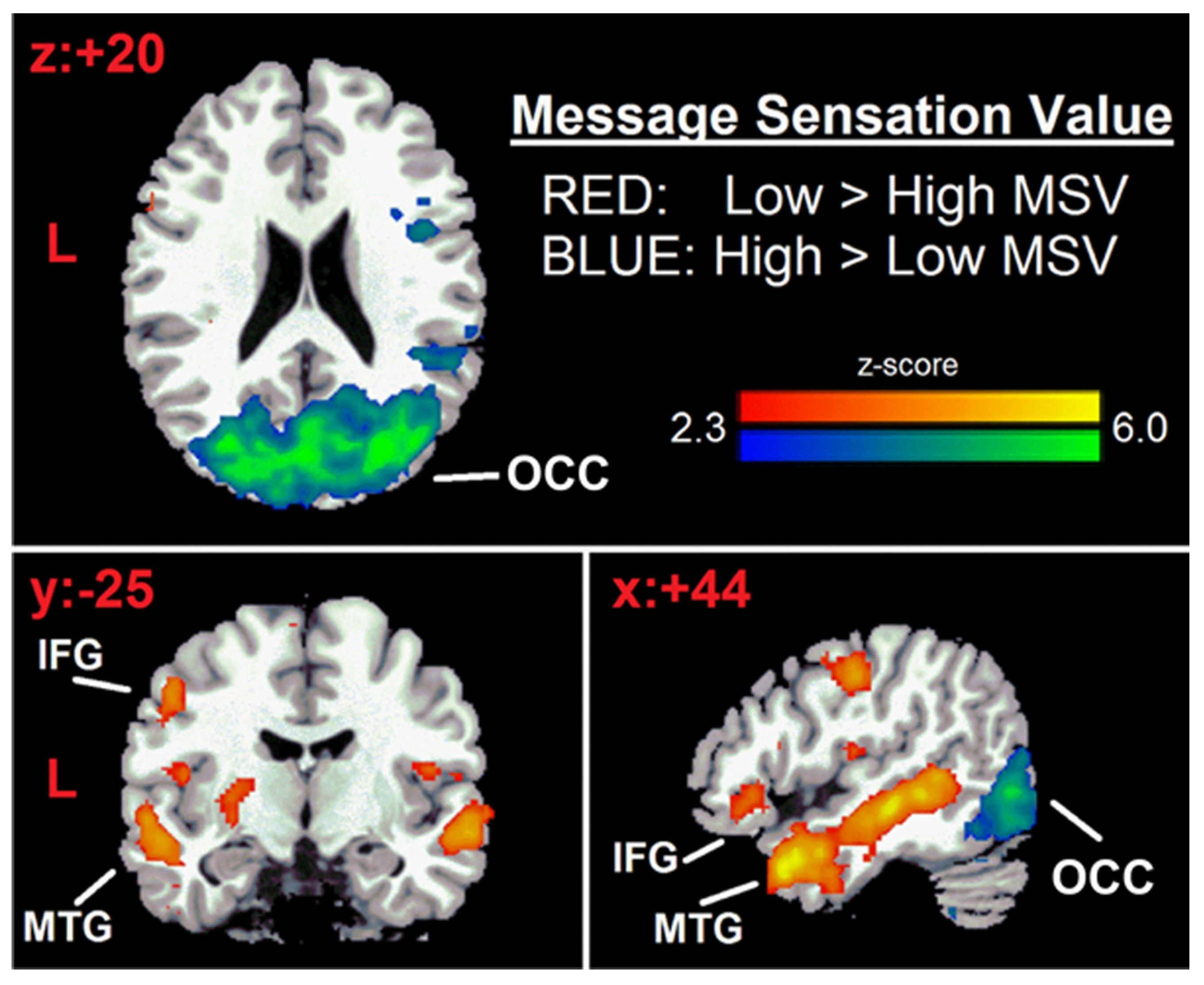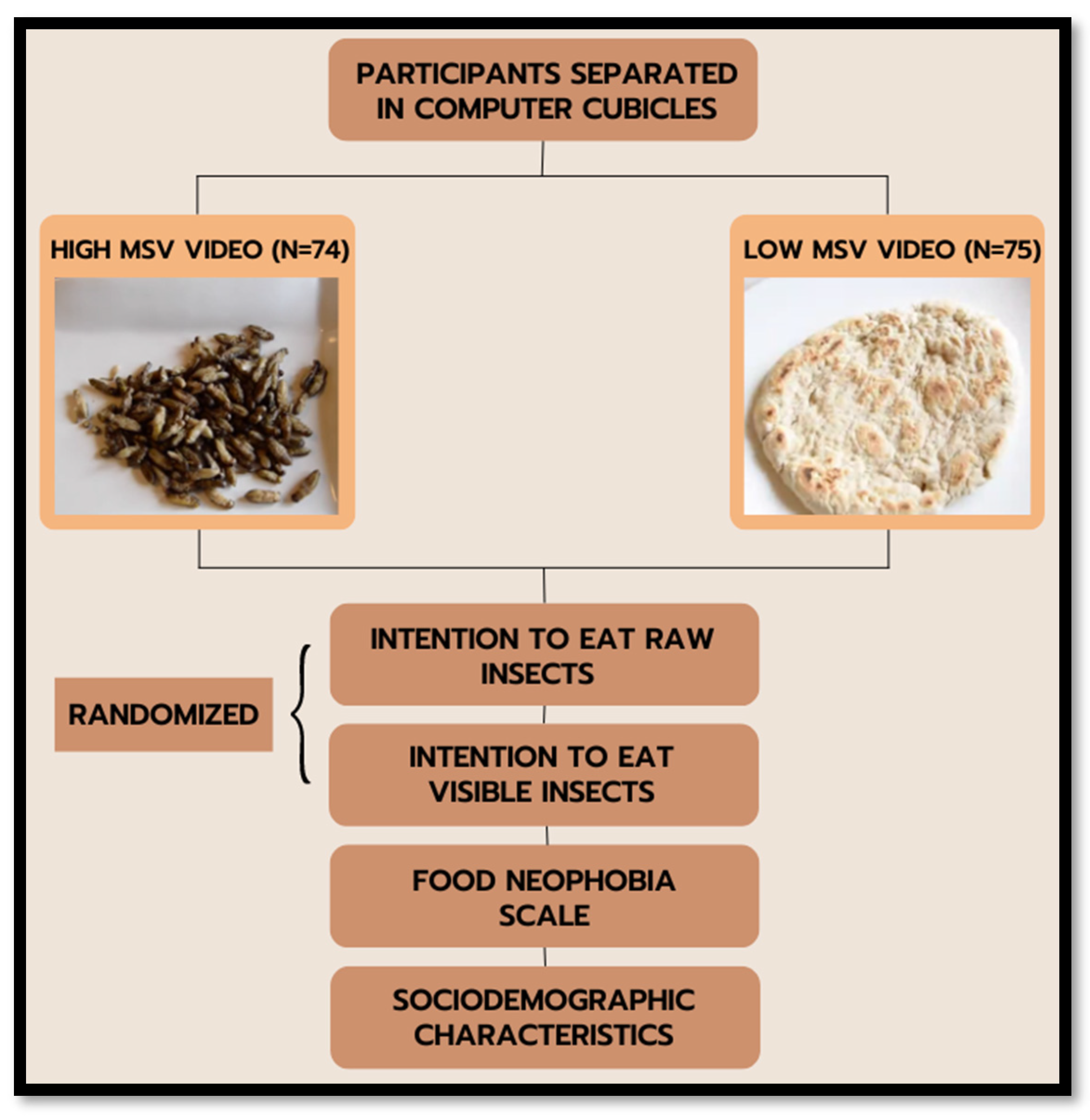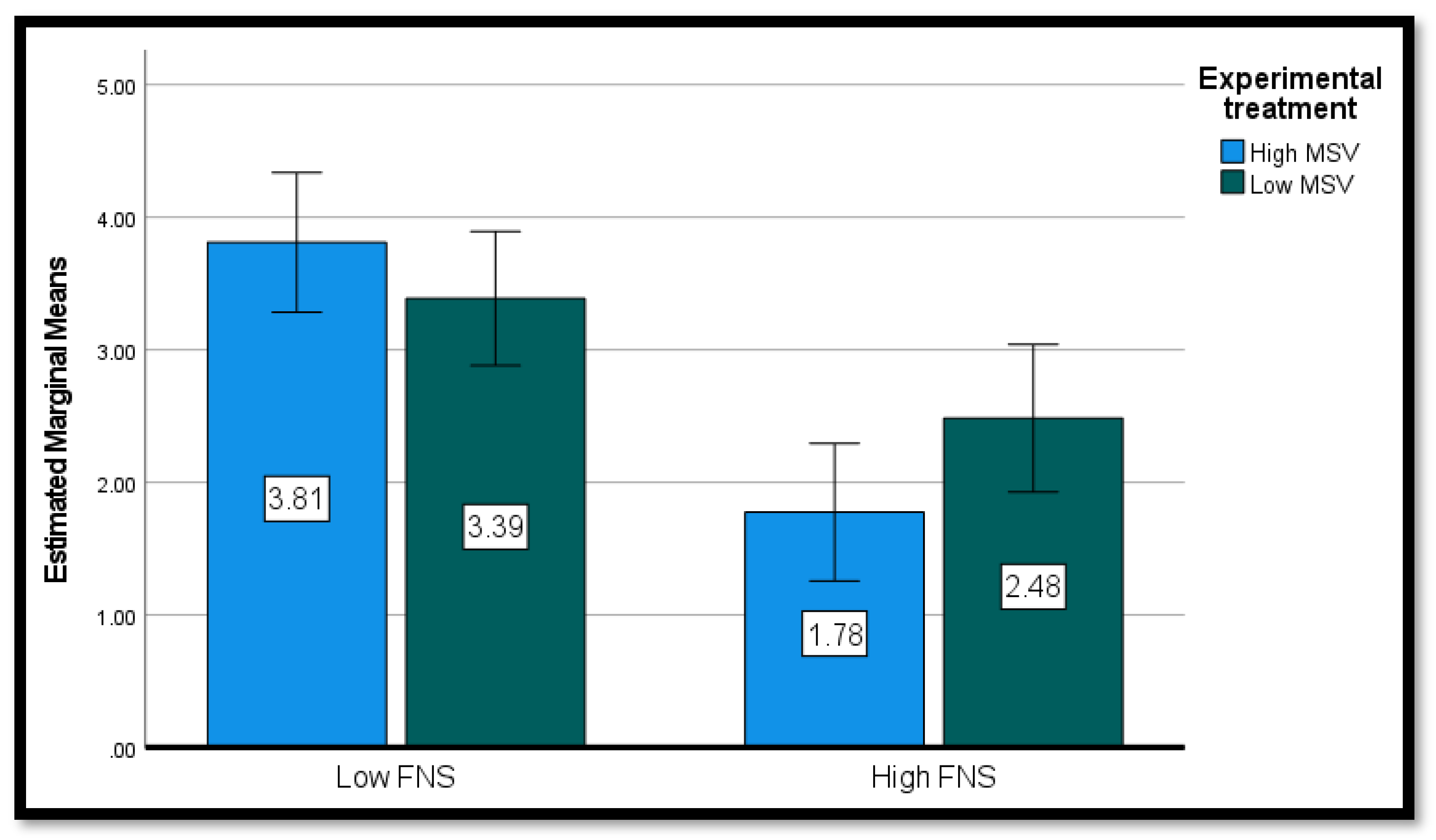The Interaction between Message Sensation Value and Food Neophobia in Communication about Insect-Based Foods: An Experiment with Italian Consumers
Abstract
1. Introduction
1.1. The Role of Communication in Guiding Consumers’ Choice
- -
- emotional arousal: a message with high perceived MSV is seen as emotional, arousing, involving, exciting, and powerful;
- -
- dramatic impact: a message with high perceived MSV is seen as dramatic, creative, and intense;
- -
- novelty: a message with high perceived MSV is seen as novel and unusual.
1.2. Aims and Hypothesis
2. Materials and Methods
2.1. Measures
2.2. Statistical Analyses
3. Results
4. Discussion
5. Conclusions
Author Contributions
Funding
Institutional Review Board Statement
Informed Consent Statement
Data Availability Statement
Conflicts of Interest
References
- World Population Prospects 2022: Summary of Results; United Nations Department of Economic and Social Affairs, Population Division, Ed.; United Nations Publication: San Francisco, CA, USA, 2022.
- The State of Food Security and Nutrition in the World 2022|FAO|Food and Agriculture Organization of the United Nations. Available online: https://www.fao.org/publications/sofi/2022/en/ (accessed on 13 September 2022).
- Raheem, D.; Raposo, A.; Oluwole, O.B.; Nieuwland, M.; Saraiva, A.; Carrascosa, C. Entomophagy: Nutritional, Ecological, Safety and Legislation Aspects. Food Res. Int. 2019, 126, 108672. [Google Scholar] [CrossRef]
- Oonincx, D.G.A.B.; van Broekhoven, S.; van Huis, A.; van Loon, J.J.A. Feed Conversion, Survival and Development, and Composition of Four Insect Species on Diets Composed of Food By-Products. PLoS ONE 2015, 10, e0144601. [Google Scholar] [CrossRef] [PubMed]
- Halloran, A.; Hanboonsong, Y.; Roos, N.; Bruun, S. Life Cycle Assessment of Cricket Farming in North-Eastern Thailand. J. Clean. Prod. 2017, 156, 83–94. [Google Scholar] [CrossRef]
- Nadeau, L.; Nadeau, I.; Franklin, F.; Dunkel, F. The Potential for Entomophagy to Address Undernutrition. Ecol. Food Nutr. 2015, 54, 200–208. [Google Scholar] [CrossRef] [PubMed]
- IPIFF. Edible Insects on the European Market. Available online: https://ipiff.org/wp-content/uploads/2020/06/10-06-2020-IPIFF-edible-insects-market-factsheet.pdf (accessed on 14 September 2022).
- Deroy, O.; Reade, B.; Spence, C. The Insectivore’s Dilemma, and How to Take the West out of It. Food Qual. Prefer. 2015, 44, 44–55. [Google Scholar] [CrossRef]
- Dagevos, H. A Literature Review of Consumer Research on Edible Insects: Recent Evidence and New Vistas from 2019 Studies. J. Insects Food Feed 2021, 7, 249–259. [Google Scholar] [CrossRef]
- Ardoin, R.; Prinyawiwatkul, W. Consumer Perceptions of Insect Consumption: A Review of Western Research since 2015. Int. J. Food Sci. Technol. 2021, 56, 4942–4958. [Google Scholar] [CrossRef]
- de Carvalho, N.M.; Madureira, A.R.; Pintado, M.E. The Potential of Insects as Food Sources—A Review. Crit. Rev. Food Sci. Nutr. 2020, 60, 3642–3652. [Google Scholar] [CrossRef]
- Kröger, T.; Dupont, J.; Büsing, L.; Fiebelkorn, F. Acceptance of Insect-Based Food Products in Western Societies: A Systematic Review. Front. Nutr. 2022, 8, 759885. [Google Scholar] [CrossRef]
- Onwezen, M.C.; Bouwman, E.P.; Reinders, M.J.; Dagevos, H. A Systematic Review on Consumer Acceptance of Alternative Proteins: Pulses, Algae, Insects, Plant-Based Meat Alternatives, and Cultured Meat. Appetite 2021, 159, 105058. [Google Scholar] [CrossRef]
- Sogari, G.; Menozzi, D.; Mora, C. Sensory-liking Expectations and Perceptions of Processed and Unprocessed Insect Products. Int. J. Food Syst. Dyn. 2018, 9, 314–320. [Google Scholar] [CrossRef]
- Wendin, K.M.; Nyberg, M.E. Factors Influencing Consumer Perception and Acceptability of Insect-Based Foods. Curr. Opin. Food Sci. 2021, 40, 67–71. [Google Scholar] [CrossRef]
- Aldridge, V.; Dovey, T.M.; Halford, J.C.G. The Role of Familiarity in Dietary Development. Dev. Rev. 2009, 29, 32–44. [Google Scholar] [CrossRef]
- Larson, N.; Story, M. A Review of Environmental Influences on Food Choices. Ann. Behav. Med. 2009, 38, 56–73. [Google Scholar] [CrossRef] [PubMed]
- Verneau, F.; La Barbera, F.; Kolle, S.; Amato, M.; Del Giudice, T.; Grunert, K. The Effect of Communication and Implicit Associations on Consuming Insects: An Experiment in Denmark and Italy. Appetite 2016, 106, 30–36. [Google Scholar] [CrossRef]
- Hovland, C.I.; Janis, I.L.; Kelley, H.H. Communication and Persuasion; Yale University Press: New Haven, CT, USA, 1953. [Google Scholar]
- Dubé, L.; Cantin, I. Promoting Health or Promoting Pleasure? A Contingency Approach to the Effect of Informational and Emotional Appeals on Food Liking and Consumption. Appetite 2000, 35, 251–262. [Google Scholar] [CrossRef]
- Morgan, S.E.; Palmgreen, P.; Stephenson, M.T.; Hoyle, R.H.; Lorch, E.P. Associations Between Message Features and Subjective Evaluations of the Sensation Value of Antidrug Public Service Announcements. J. Commun. 2003, 53, 512–526. [Google Scholar] [CrossRef]
- Palmgreen, P.; Stephenson, M.T.; Everett, M.W.; Baseheart, J.R.; Francies, R. Perceived Message Sensation Value (PMSV) and the Dimensions and Validation of a PMSV Scale. Health Commun. 2002, 14, 403–428. [Google Scholar] [CrossRef]
- Harrington, N.G.; Lane, D.R.; Donohew, L.; Zimmerman, R.S.; Norling, G.R.; An, J.-H.; Cheah, W.H.; McClure, L.; Buckingham, T.; Garofalo, E.; et al. Persuasive Strategies for Effective Anti-Drug Messages. Commun. Monogr. 2003, 70, 16–38. [Google Scholar] [CrossRef]
- Palmgreen, P.; Donohew, L.; Lorch, E.P.; Rogus, M.; Helm, D.; Grant, N. Sensation Seeking, Message Sensation Value, and Drug Use as Mediators of PSA Effectiveness. Health Commun. 1991, 3, 217–227. [Google Scholar] [CrossRef]
- Petty, R.E.; Cacioppo, J.T. The Elaboration Likelihood Model of Persuasion. In Communication and Persuasion; Springer: New York, NY, USA, 1986; pp. 1–24. ISBN 978-1-4612-9378-1. [Google Scholar]
- Stephenson, M.T.; Southwell, B.G. Sensation Seeking, the Activation Model, and Mass Media Health Campaigns: Current Findings and Future Directions for Cancer Communication. J. Commun. 2006, 56, S38–S56. [Google Scholar] [CrossRef]
- Seelig, D.; Wang, A.-L.; Jaganathan, K.; Loughead, J.W.; Blady, S.J.; Childress, A.R.; Romer, D.; Langleben, D.D. Low Message Sensation Health Promotion Videos Are Better Remembered and Activate Areas of the Brain Associated with Memory Encoding. PLoS ONE 2014, 9, e113256. [Google Scholar] [CrossRef] [PubMed]
- Langleben, D.D.; Loughead, J.W.; Ruparel, K.; Hakun, J.G.; Busch-Winokur, S.; Holloway, M.B.; Strasser, A.A.; Cappella, J.N.; Lerman, C. Reduced Prefrontal and Temporal Processing and Recall of High “Sensation Value” Ads. NeuroImage 2009, 46, 219–225. [Google Scholar] [CrossRef] [PubMed]
- Chattopadhyay, A.; Laborie, J.-L. Managing Brand Experience: The Market Contact AuditTM. J. Advert. Res. 2005, 45, 9–16. [Google Scholar] [CrossRef]
- D’Silva, M.U.; Palmgreen, P. Individual Differences and Context: Factors Mediating Recall of Anti-Drug Public Service Announcements. Health Commun. 2007, 21, 65–71. [Google Scholar] [CrossRef]
- Helme, D.W.; Donohew, R.L.; Baier, M.; Zittleman, L. A Classroom-Administered Simulation of a Television Campaign on Adolescent Smoking: Testing an Activation Model of Information Exposure. J. Health Commun. 2007, 12, 399–415. [Google Scholar] [CrossRef] [PubMed]
- Russell, C.A.; Belch, M. A Managerial Investigation into the Product Placement Industry. J. Advert. Res. 2005, 45, 73–92. [Google Scholar] [CrossRef]
- Indovina, I.; Macaluso, E. Dissociation of Stimulus Relevance and Saliency Factors during Shifts of Visuospatial Attention. Cereb. Cortex 2007, 17, 1701–1711. [Google Scholar] [CrossRef]
- Kang, H.; Hahn, M.; Fortin, D.R.; Hyun, Y.J.; Eom, Y. Effects of Perceived Behavioral Control on the Consumer Usage Intention of E-Coupons. Psychol. Mark. 2006, 23, 841–864. [Google Scholar] [CrossRef]
- Everett, M.W.; Palmgreen, P. Influences of Sensation Seeking, Message Sensation Value, and Program Context on Effectiveness of Anticocaine Public Service Announcements. Health Commun. 1995, 7, 225–248. [Google Scholar] [CrossRef]
- Quick, B.L. Perceived Message Sensation Value and Psychological Reactance: A Test of the Dominant Thought Disruption Hypothesis. J. Health Commun. 2013, 18, 1024–1038. [Google Scholar] [CrossRef] [PubMed]
- Hartmann, C.; Shi, J.; Giusto, A.; Siegrist, M. The Psychology of Eating Insects: A Cross-Cultural Comparison between Germany and China. Food Qual. Prefer. 2015, 44, 148–156. [Google Scholar] [CrossRef]
- Martins, Y.; Pliner, P. “Ugh! That’s Disgusting!”: Identification of the Characteristics of Foods Underlying Rejections Based on Disgust. Appetite 2006, 46, 75–85. [Google Scholar] [CrossRef] [PubMed]
- Van Huis, A.; Van Itterbeeck, J.; Klunder, H.; Mertens, E.; Halloran, A.; Muir, G.; Vantomme, P. Edible Insects: Future Prospects for Food and Feed Security; Food and Agriculture Organization of the United Nations: Rome, Italy, 2013; ISBN 92-5-107596-4. [Google Scholar]
- Ruby, M.B.; Rozin, P.; Chan, C. Determinants of Willingness to Eat Insects in the USA and India. J. Insects Food Feed 2015, 1, 215–225. [Google Scholar] [CrossRef]
- Verbeke, W. Profiling Consumers Who Are Ready to Adopt Insects as a Meat Substitute in a Western Society. Food Qual. Prefer. 2015, 39, 147–155. [Google Scholar] [CrossRef]
- Verkerk, M.C.; Tramper, J.; van Trijp, J.C.M.; Martens, D.E. Insect Cells for Human Food. Biotechnol. Adv. 2007, 25, 198–202. [Google Scholar] [CrossRef]
- La Barbera, F.; Verneau, F.; Amato, M.; Grunert, K. Understanding Westerners’ Disgust for the Eating of Insects: The Role of Food Neophobia and Implicit Associations. Food Qual. Prefer. 2018, 64, 120–125. [Google Scholar] [CrossRef]
- Pliner, P.; Hobden, K. Development of a Scale to Measure the Trait of Food Neophobia in Humans. Appetite 1992, 19, 105–120. [Google Scholar] [CrossRef]
- Tan, H.S.G.; Fischer, A.R.H.; van Trijp, H.C.M.; Stieger, M. Tasty but Nasty? Exploring the Role of Sensory-Liking and Food Appropriateness in the Willingness to Eat Unusual Novel Foods like Insects. Food Qual. Prefer. 2016, 48, 293–302. [Google Scholar] [CrossRef]
- Tan, H.S.G.; van den Berg, E.; Stieger, M. The Influence of Product Preparation, Familiarity and Individual Traits on the Consumer Acceptance of Insects as Food. Food Qual. Prefer. 2016, 52, 222–231. [Google Scholar] [CrossRef]
- Alemu, M.H.; Olsen, S.B.; Vedel, S.E.; Pambo, K.O.; Owino, V.O. Consumer Acceptance and Willingness to Pay for Edible Insects as Food in Kenya: The Case of White Winged Termites; IFRO Working Paper; University of Copenhagen, Department of Food and Resource Economics (IFRO): Copenhagen, Denmark, 2015. [Google Scholar]
- Businesscoot. The Edible Insect Market—Italy|Businesscoot. Available online: https://www.businesscoot.com/en/study/the-edible-insect-market-italy (accessed on 5 November 2022).
- La Barbera, F.; Verneau, F.; Amato, M.; Grunert, K.G.; Schnettler, B. Acceptance of Insect-Based Food in Chile: Evidence from a Survey Using the Entomophagy Attitude Questionnaire (EAQ). Food Qual. Prefer. 2021, 93, 104269. [Google Scholar] [CrossRef]
- Rojo, S. Insect Production and Utilization of Insect Products in Europe. In Insects as Animal Feed: Novel Ingredients for Use in Pet, Aquaculture and Livestock Diets; Hall, H., Fitches, E., Smith, R., Eds.; CABI International: Wallingford, UK, 2021; pp. 82–84. ISBN 9781789245929. [Google Scholar]
- Scaffardi, L.; Formici, G. Novel Foods and Edible Insects in the European Union. An Interdisciplinary Analysis; Springer: Cham, Switzerland, 2022. [Google Scholar]
- Berger, S.; Bärtsch, C.; Schmidt, C.; Christandl, F.; Wyss, A.M. When Utilitarian Claims Backfire: Advertising Content and the Uptake of Insects as Food. Front. Nutr. 2018, 5, 88. [Google Scholar] [CrossRef] [PubMed]
- Verneau, F.; La Barbera, F.; Furno, M. The Role of Health Information in Consumers’ Willingness to Pay for Canned Crushed Tomatoes Enriched with Lycopene. Nutrients 2019, 11, 2173. [Google Scholar] [CrossRef]
- Kazbare, L.; van Trijp, H.C.M.; Eskildsen, J.K. A-Priori and Post-Hoc Segmentation in the Design of Healthy Eating Campaigns. J. Mark. Commun. 2010, 16, 21–45. [Google Scholar] [CrossRef]
- Rennhak, C.; Opresnik, M.O. Marketing: Grundlagen; Studienwissen kompakt; Springer: Berlin/Heidelberg, Germany, 2016; ISBN 978-3-662-45808-2. [Google Scholar]
- Ellis, D.I.; Muhamadali, H.; Haughey, S.A.; Elliott, C.T.; Goodacre, R. Point-and-Shoot: Rapid Quantitative Detection Methods for on-Site Food Fraud Analysis—Moving out of the Laboratory and into the Food Supply Chain. Anal. Methods 2015, 7, 9401–9414. [Google Scholar] [CrossRef]
- House, J. Consumer Acceptance of Insect-Based Foods in the Netherlands: Academic and Commercial Implications. Appetite 2016, 107, 47–58. [Google Scholar] [CrossRef]
- Verneau, F.; La Barbera, F.; Amato, M.; Riverso, R.; Grunert, K.G. Assessing the Role of Food Related Lifestyle in Predicting Intention towards Edible Insects. Insects 2020, 11, 660. [Google Scholar] [CrossRef]




| Characteristics | Frequency | Sample (%) |
|---|---|---|
| Gender | ||
| Male | 43 | 28.9 |
| Female | 106 | 71.1 |
| Age | ||
| 18–23 | 110 | 73.8 |
| 24–31 | 39 | 26.2 |
| Education | ||
| High school | 81 | 54.4 |
| Bachelor level | 42 | 28.2 |
| Graduate | 26 | 14.4 |
| Household income (per month) | ||
| Less than EUR 1000 | 27 | 18.1 |
| Between EUR 1001 and 2000 | 57 | 38.3 |
| Between EUR 2001 and 3000 | 48 | 32.2 |
| More than EUR 3001 | 17 | 11.4 |
| Household size (components’ number) | ||
| 1 | 2 | 1.3 |
| 2 | 1 | 0.7 |
| 3 | 21 | 14.1 |
| 4 | 77 | 51.7 |
| More than 4 | 48 | 32.2 |
| Food Neophobia Scale (Cronbach’s α = 0.87) | Mean (SD) |
|---|---|
| I don’t trust new foods | 2.75 (1.73) |
| I’m very particular about the foods I will eat | 4.14 (2.13) |
| If I don’t know what is in a food, I won’t try it | 3.70 (1.97) |
| I will eat almost everything * | 3.35 (2.13) |
| I’m afraid to eat things I have never had before | 2.97 (1.97) |
| I’m constantly sampling new and different foods * | 3.17 (1.74) |
| I like to try new ethnic restaurants * | 3.24 (1.96) |
| I like foods from different countries * | 2.52 (1.64) |
| At dinner parties, I will try a new food * | 2.93 (1.62) |
| Ethnic food looks too weird to eat | 2.53 (1.61) |
| Low MSV | High MSV | |
|---|---|---|
| Low FNS | 1.71 a (1.09) | 2.52 b (1.37) |
| High FNS | 1.23 c (0.66) | 1.16 c (0.31) |
| Low MSV | High MSV | |
|---|---|---|
| Low FNS | 3.38 a (1.80) | 3.81 a (1.81) |
| High FNS | 2.48 b (1.66) | 1.78 c (1.08) |
Disclaimer/Publisher’s Note: The statements, opinions and data contained in all publications are solely those of the individual author(s) and contributor(s) and not of MDPI and/or the editor(s). MDPI and/or the editor(s) disclaim responsibility for any injury to people or property resulting from any ideas, methods, instructions or products referred to in the content. |
© 2022 by the authors. Licensee MDPI, Basel, Switzerland. This article is an open access article distributed under the terms and conditions of the Creative Commons Attribution (CC BY) license (https://creativecommons.org/licenses/by/4.0/).
Share and Cite
Riverso, R.; Amato, M.; Verneau, F.; La Barbera, F. The Interaction between Message Sensation Value and Food Neophobia in Communication about Insect-Based Foods: An Experiment with Italian Consumers. Nutrients 2023, 15, 191. https://doi.org/10.3390/nu15010191
Riverso R, Amato M, Verneau F, La Barbera F. The Interaction between Message Sensation Value and Food Neophobia in Communication about Insect-Based Foods: An Experiment with Italian Consumers. Nutrients. 2023; 15(1):191. https://doi.org/10.3390/nu15010191
Chicago/Turabian StyleRiverso, Roberta, Mario Amato, Fabio Verneau, and Francesco La Barbera. 2023. "The Interaction between Message Sensation Value and Food Neophobia in Communication about Insect-Based Foods: An Experiment with Italian Consumers" Nutrients 15, no. 1: 191. https://doi.org/10.3390/nu15010191
APA StyleRiverso, R., Amato, M., Verneau, F., & La Barbera, F. (2023). The Interaction between Message Sensation Value and Food Neophobia in Communication about Insect-Based Foods: An Experiment with Italian Consumers. Nutrients, 15(1), 191. https://doi.org/10.3390/nu15010191







